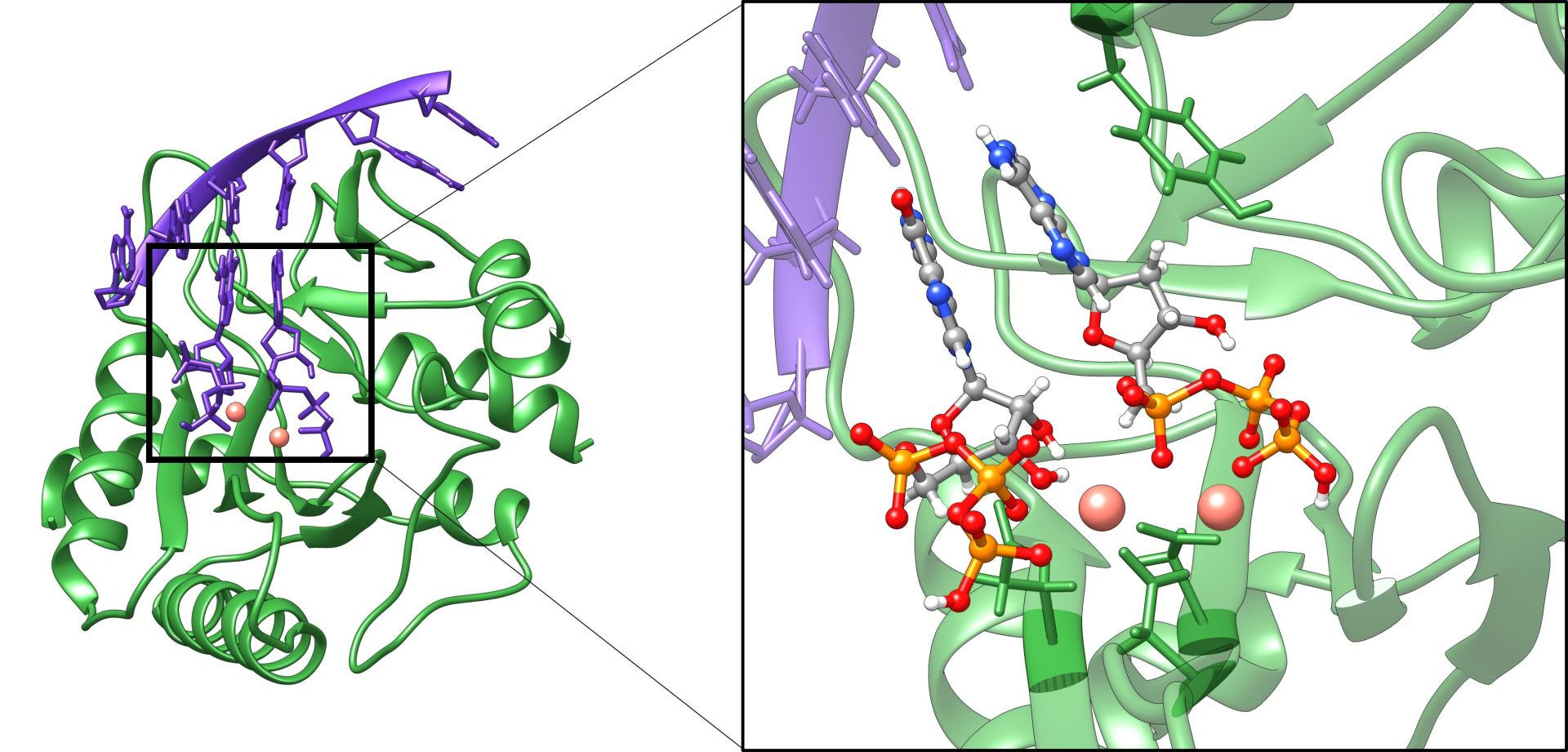
The precise details of some specific steps needed to initiate DNA replication have remained beyond researchers’ grasp. But now a UT Dallas graduate student, Madison Berger, and her supervisor, NS&M Professor G. Andrés Cisneros, in collaboration with researchers from the University of Sussex, have used quantum mechanical principles to help successfully uncover the initiation sequence of primer synthesis in the active site for DNA replication.
“Even though researchers have been looking at it for decades, this particular piece of the puzzle was not known until now, and so that’s why this work is important,” Cisneros said.
DNA primer is required not only to start the replication process but also to ensure it works the same way every time.
Replication is the process by which DNA is copied in cells. And for researchers working in this field, it must be correct in every detail as there is no room for error.
Their discovery would not have been possible without interdisciplinary work in computational biophysics. The team’s research paper, titled “The Molecular Basis for the Initiation of DNA Primer Synthesis,” was recently published in the scientific journal, Nature.
“Based on structures and experiments, the Sussex team was able to make a hypothesis about what interactions occur that are in the region where the chemical reaction takes place, called the active site. Our calculations helped provide further clarification and explanation of the interactions required to maintain the position of the molecules in the active site for the chemical reaction to occur,” Berger said.
“The goal of our study is to understand how the process of starting to synthesize DNA happens,” Berger said.

Berger and Cisneros are part of a wider international team of scientists working on various pieces of this problem. A team from the University of Sussex in the United Kingdom successfully crystallized and characterized the CRISPR-associated Primase Polymerase or CAPP protein from the Marinitoga piezophill bacterium.
This initiation sequence is offered, for the first time, at the molecular level. In addition to applying traditional biochemical pathways, quantum biophysics was used to precisely identify the atoms, molecules and electrons involved to learn what was needed to produce the perfect primer.
DNA primer is required not only to start the replication process but also to ensure it works the same way every time.
“The use of experimental and computational techniques that allow us to understand the system at the molecular level was what enabled us to elucidate many details of the DNA primase,” Berger said.
“We needed to go to quantum mechanics to literally tease out what are the specific interactions between the different molecules in this part of the enzyme called the active site, where the reaction happens so that we could help explain what was going on,” Cisneros said.
“You’ve got six negative charges all in the same place. And we found that there are other pieces near those six charges that are very important for this entire primase-polymerase reaction to occur. You’ve got to have those two DNA bases – one’s DNA, one’s RNA. You also must have two magnesium ions, each have a + 2 charge.
Berger described it this way: “There needs to be an exquisite balance of molecular interactions in the active site so DNA can start being copied or synthesized, and this balance is achieved by a combination of the protein, and two specific metals in the active site, in this case magnesium ions.
“And then there are other neighboring residues that are actually part of this primase that help carry out this reaction by sort of distributing the charge,” Berger said.
The two positive metal ions make it so that “everything in the end is kind of neutral and it works beautifully,” Cisneros said.
Cisneros said their research is supported by grants from the National Science Foundation and the National Institutes of Health.
DNA Replication Steps
Template sliding – MsPP, the CAPP that was investigated in the paper, moves along the DNA guide strand, or template, to find the region to start the synthesis.
Primer initiation – MsPP has found the DNA region to start the DNA synthesis and loads a ribonucleic acid in the initiation site (I-site), followed by a deoxyribonucleic acid in the extension site (E-site) and the chemical reaction to bind these two.
DNA translocation – MsPP moves along the DNA “one step” to the next nucleic acid on the template so that the nucleic acid that was on the E-site moves to the I-site and then a new deoxyribonucleic acid molecule can be loaded onto the E-site.
Help us leave the planet a better place for future generations. Your support for the School of Natural Sciences and Mathematics funds scientific discoveries with real-world applications, student and faculty recruitment, and academic scholarships.